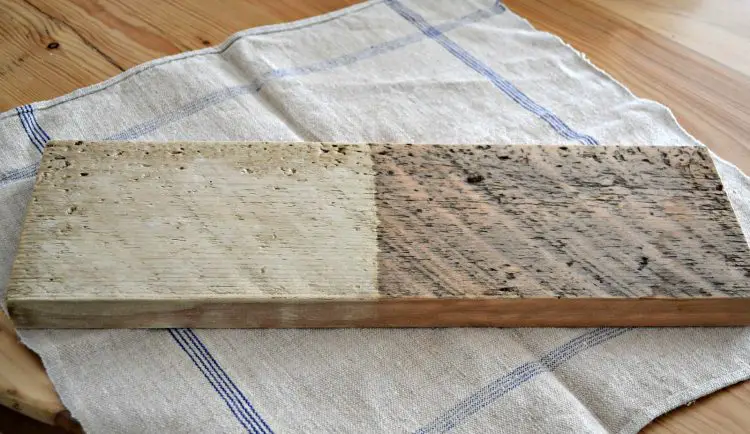I get all sorts of enquiries about refinishing old pieces of furniture. There are people who want to transform older pieces and put the wood to its best use. After the varnish or paint has been removed by various methods (paint stripper, thinner, sanding, sandblasting), the wood may still be covered with paint marks, stained or with pores marked because the varnish has gone deep into the wood. In this case, how can you fading wood so that it can be refinished as if the wood had nothing on top?
A very handy product is the îlaundry bleachthat is, products containing sodium hypochlorite between 1 and 5%. If it also has some caustic soda (0.1-1%) it is even better. Apply the product with a brush or cloth to the surface of the varnish-cleaned wood and allow to dry. Repeat 2-3 times for best results. The bleaching effect is enhanced by the sun. Allowing the wood to dry in the sun will make the action of the hypochlorite even more effective. After drying, the wood should not be washed with water but brushed to remove the salts left by brushing.

Bleach attacks dyes but does not attack paints or pigment-based coloring solutions. In other words, if the wood has been stained with stain, using bleach can discolor it. However, if it has been stained with paint or special pigment-based stains have been used, they cannot be removed.
It's good to know that hypochlorite doesn't attack the natural color of wood, so if you want to preserve the natural color of wood, you can use it without worry.
Another product that can be used to remove some remaining stains is oxalic acid. It is very good against water stains on wood or rust stains, marks left by old nails or hardware. To prevent damage, when treating wood with oxalic acid, the hardware must be removed. Oxalic acid is found in crystal form and is dissolved in solution in warm water. As with bleach, the solution is applied and allowed to dry, after which the salts are removed by brushing.

Oxalic acid can also be used to remove the gray color that results from the natural oxidation of wood in the sun.

If the wood also shows traces of blue mold it can be treated with perhydrol (hydrogen peroxide solution 35%) It should be borne in mind that perhydrol also attacks the natural color of the wood and discolors it. The solution is applied to the entire surface and left until the following day. There is no need to wash the wood afterwards because hydrogen peroxide leaves no residue.

A mixture of caustic soda and perhydrol 2:1. It is the classic wood bleaching mixture, presented as solution A and solution B, with instructions for mixing and use.

If you need something even more aggressive for discoloring wood, you can use perhydrol and ammoniasolution 35%. The solutions are not mixed but applied one on top of the other. First apply hydrogen peroxide, in excess, then apply ammonia. After 2 hours rinse with plenty of water and allow to dry. Be careful, bleached wood should not be finished with polyurethane products because the hardener will yellow. In such cases it is recommended acrylic finish.
All these processes are quite aggressive. That is why you should wear gloves, mask, goggles and appropriate equipment when using the materials. Buy the materials from specialized shops and follow the instructions for use and protection exactly.

































"First apply hydrogen peroxide, in excess, then apply ammonia."... what needs to be there!!! I guess you can't do that in the house, only someone who is lucky to have a yard, an outdoor space....
Can you do that if the furniture is chipboard with wood veneer? I guess not...
It is possible! The veneer is thick enough to withstand the strain and the adhesive is strong.
where can I find oxalic acid .thank you
It is a product that is also used in stucco. It can be found at such shops or in shops where you can find chemicals (like Tehnometal from the old days). Search on the net, it's the easiest.
In what proportion is oxalic acid put in the water to remove oxidised (grey) stains from the wood? Also valid for tannins (greenish stains)? thank you,
Good evening,
The bleaching mixture is 2 tablespoons oxalic acid (50-60 g) to 250 ml water. It should also attack tannins. You can apply several times for a better effect.
All the best!
Thank you very much 🙂
After months of searching and trying with oxalic acid, hydrogen peroxide and others I finally found a product available in Romania that works on scraped wood, it's a product called: Net-Trol from the company Owatrol.
It costs 50-60 RON but it's the only one that has worked on solid oak floors. It doesn't smell, it doesn't leave marks, you're amazed by the results and that's why I wanted to share the result here. And if you want the floor to come out perfect, a colour that brings out the natural wood, you have to use primer from another famous company: Bona. Then with varnish also from them and that's the only way you have a beautiful, like new parquet.
It costs a bit but in the end you're happy.
I am looking for a colour opening solution also for an old solid oak floor. Can you please tell me if your flooring was solid golden oak?